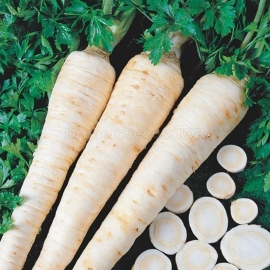
«Hamburg Sugary» - Organic Root Parsley Seeds
1.14 €
Hamburg Rooted parsley has a slightly different use than other parsley varieties! This old fashioned heirloom variety produces fleshy parsnip-like roots up to 10 inches long that are cooked as a vegetable!
-
Heirloom Root Parsley «Hamburg Sugary»
Hamburg Rooted parsley has a slightly different use than other parsley varieties! This old fashioned heirloom variety produces fleshy parsnip-like roots up to 10 inches long that are cooked as a vegetable!
Dark green leaves may be used like ordinary parsley and are great for salads! Roots mature in 85-95 days. Attractive to bees, butterflies and/or birds! Parsley has a long and colorful history, being well known in many cultures. Myths and legends abound concerning this herb, making it the symbol of such widely varying things as death, victory, and life.
One colonial superstition connecting parsley with death held such power that many farmers refused to grow this herb at all. Curly leaved parsley is the most well known and commonly available herb; it contains vitamins A and C as well as other valuable antioxidants, vitamins, and minerals.
How to Grow
Parsley root plants can be grown from seed. The roots need a long growing season to develop, so start them indoors 5-6 weeks before the last frost date if you live in an area with hard winters. Germination can take as long as 3 weeks, so soak the seeds for 12 hours in warm water first to help it along. When your parsley root plants are 3 inches (7.5 cm) tall, harden them off outdoors, then transplant them when all risk of frost has passed.
In hot areas without frost, plant your parsley root plants during the cool season in autumn, winter, or early spring. Growing parsley root plants like rich loamy soil and frequent watering. They can also be grown in containers provided they are deep enough to accommodate the long roots. Parsley root harvesting happens in phases.
If you’re after the leaves, cut the outer stalks off at ground level to encourage new growth. Always leave the inner stalks in place. At the end of the growing season, dig up the entire plant and separate the stalks from the root. Store the root in damp sand or peat and freeze or dry the leaves.
